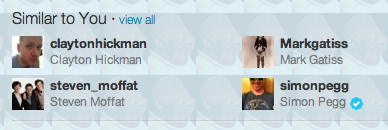Simon Guerrier's Blog, page 104
January 27, 2011
Old reviews: Johannes Cabal - the Necromancer
Here's a book review of Johannes Cabal - the Necromancer by Jonathan L Howard, which I wrote for Vector in the summer of 2009 and never got round to posting here:
Johannes Cabal has made a deal with the devil. He's already sold his soul; the deal is to win it back. Cabal has one year to claim 100 other souls, and Satan's even going to throw in the means with which to claim them. Soon Cabal is in charge of a travelling carnival, with something to tempt every punter.
But Cabal has obstacles in his way: rival villains and wizards, concerned local residents and his own vampiric brother. And he can only use his dark powers sparingly; they're linked to a ball of black blood down in Hell that shrinks every time he performs a spell.
There's all the makings of a rich and lively adventure here, but sadly it never quite works. The ball of black blood, for example, is forgotten as soon as it's introduced. Rather than curbing Cabal's efforts, he seems to do just what he likes.
Nor the year's deadline feel much of a ticking clock. Cabal sets up his carnival, claims his first victims and makes excuses for a few more. The middle chapters are unconnected episodes: Cabal getting caught in a hell dimension, or the carnival as seen by a small boy. Then, without much sense of time passing, or how the carnival and its staff have developed, we skip to the end and a race for the last two victims. There's no sense of time passing, of the seasons changing, of the strain Cabal is under. In fact, while he may get a bit cross when inconvenienced, there's little sense that events really affect him.
Cabal's brother, Horst, acts as his conscience. The vampire struggling to go without blood is not a hugely original idea. There's no new spin on the character here. Horst chides Cabal and helps save a few worthy souls, but is powerless to sway his brother. The later stages of the book would have worked better had Horst had more influence, or suggested Cabal is more conflicted than he lets on.
As it is, we don't feel any great pressure on Cabal. And to be honest, until the last couple of pages we're given little reason to root for him, either. He's pompous, arched and sarcastic without ever quite straying into wit. That in itself is a major problem for what's meant to be a darkly comic novel. It simply isn't all that funny, dramatic or original.
The denouement hangs on whether Cabal will claim the souls of two poor, innocent women to meet his deadline. But with almost no indication of his having any scruples, this hardly works as a crisis of character.
And yet the last two pages reveal why Cabal sold his soul in the first place, and why to reclaim it again he's gone to such effort and given up so much. There's the first hint of a much more complex, conflicted and interesting character there. One who may well support a continuing series.
Johannes Cabal has made a deal with the devil. He's already sold his soul; the deal is to win it back. Cabal has one year to claim 100 other souls, and Satan's even going to throw in the means with which to claim them. Soon Cabal is in charge of a travelling carnival, with something to tempt every punter.
But Cabal has obstacles in his way: rival villains and wizards, concerned local residents and his own vampiric brother. And he can only use his dark powers sparingly; they're linked to a ball of black blood down in Hell that shrinks every time he performs a spell.
There's all the makings of a rich and lively adventure here, but sadly it never quite works. The ball of black blood, for example, is forgotten as soon as it's introduced. Rather than curbing Cabal's efforts, he seems to do just what he likes.
Nor the year's deadline feel much of a ticking clock. Cabal sets up his carnival, claims his first victims and makes excuses for a few more. The middle chapters are unconnected episodes: Cabal getting caught in a hell dimension, or the carnival as seen by a small boy. Then, without much sense of time passing, or how the carnival and its staff have developed, we skip to the end and a race for the last two victims. There's no sense of time passing, of the seasons changing, of the strain Cabal is under. In fact, while he may get a bit cross when inconvenienced, there's little sense that events really affect him.
Cabal's brother, Horst, acts as his conscience. The vampire struggling to go without blood is not a hugely original idea. There's no new spin on the character here. Horst chides Cabal and helps save a few worthy souls, but is powerless to sway his brother. The later stages of the book would have worked better had Horst had more influence, or suggested Cabal is more conflicted than he lets on.
As it is, we don't feel any great pressure on Cabal. And to be honest, until the last couple of pages we're given little reason to root for him, either. He's pompous, arched and sarcastic without ever quite straying into wit. That in itself is a major problem for what's meant to be a darkly comic novel. It simply isn't all that funny, dramatic or original.
The denouement hangs on whether Cabal will claim the souls of two poor, innocent women to meet his deadline. But with almost no indication of his having any scruples, this hardly works as a crisis of character.
And yet the last two pages reveal why Cabal sold his soul in the first place, and why to reclaim it again he's gone to such effort and given up so much. There's the first hint of a much more complex, conflicted and interesting character there. One who may well support a continuing series.
Published on January 27, 2011 11:59
January 26, 2011
Salonica
Spent a long weekend in Thessaloniki (also known as Salonica) in northern Greece with the Dr and my parents. Traipsed through a fair few museums and old churches and ate a lot of nice food.
I managed the first 200 pages of Mark Mazower's Salonica, which is brilliantly rich and well researched but a bit heavy for holiday reading. He charts the complex, multi-ethnic history of the city under Ottoman rule, comparing the different customs, manners and superstitions:
Sadly, a lot of the main museum was closed while we were there, but what we did mooch round was beautifully displayed and interpreted. The Dr especially liked seeing a Roman-period dining table recreated 'live' from a contemporary illustration and using real artefacts.
The Museum of Byzantine Culture was free and quick to look round, with some nicely displayed bits of fresco. We tried several attempts to get into the open-air Roman forum, but always managed to find it closed so took pictures from the edges.
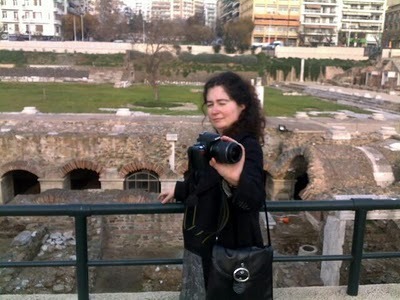
On our second full day, the Dr expertly guided us out by bus to the bus station (always well out of town in Greek cities), and thence onto a bus to Vergina and the tumulus tomb where Alexander the Great buried his dad, Phillip II. It took a bit of wandering through the drizzle to find, and then it didn't look much - a bit of grassy hillock.
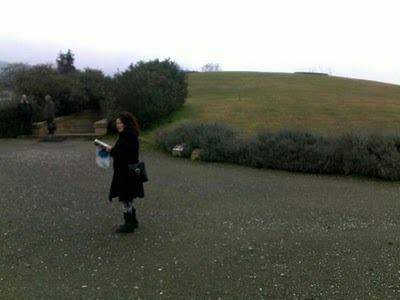
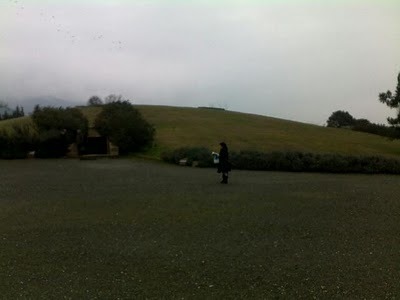
But inside was something else entirely: the most amazing museum of all the spectacular riches discovered in the tombs, right next to the tomb doorways in situ. The low-light only enhanced the splendor of the gold, but it was the simple, practical and perfectly preserved cups and pots that impressed - it was hard to believe they were 250 let alone 2,500 years old.
The haul included organic relics - so rare in archaeology of this age. There was a purple cloth with gold thread design, carvings in wood and ivory.
The tomb doorway showed a rare example of ancient Greek fresco painting, showing a hunting scene. On the tops of the doors were still vivid, bright highlights of orange and blue - again, a small detail that makes this ancient, strange civilisation so tangible.
If there was one slight off note, it was the insistence of some of the labels to explain that the finds showed that this ancient civilisation was characteristially Greek - a political claim as much to do with Macedonia's recent history as the past. The god-king buried here in such finery would have sat uncomfortably with the hellenic Spartans and Athenians - who so famously managed without monarchy. It was telling, not showing, forcing an opinion rather than letting us interpret the facts.
But otherwise, it was an extraordinary place and we dawdled round at the end, not really wanting to leave. (It was also all a bit The Daemons - an iconic image of Alexander even showed him with horns.)
The next day we tried Pella, Phillip's capital city and the birthplace of Alexander. This time, our bus efforts were less successful. First we ended up in Giannitsa because our bus driver forgot to drop us off in the right place, despite the Dr asking him specifically beforehand and his nodding as she pointed at the word 'Pella' on our ticket. In Giannitsa he only shook his head - we should have called out to stop the bus when we wanted to get off, what with our psychic knowledge of Macedonia having not visited before, and ignoring the fact that (as we discovered on the bus back again) that he'd not taken the Pella road in the first place.
And we'd been watching very carefully, too - because all along the route there were impressive tumulus tombs in the otherwise flat plains of farmland, all of them cool and alluring, and none of them labelled in big letters so you could identify them from the road.
The bus back deposited us in the pouring rain at a lowly bus stop with a big sign declaring 'Pella' and a map of where things might be.
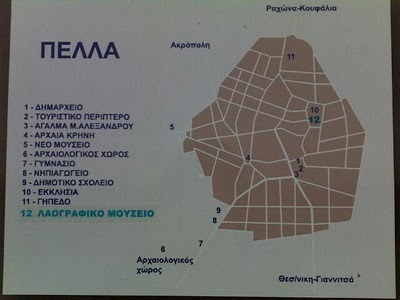 This solitary map was some way out of town, so we schlepped up through the lashing rain away from it and wandered round and round the town, stopping to take photos of our sodden holiday at the ankles of a big statue of Alexander.
This solitary map was some way out of town, so we schlepped up through the lashing rain away from it and wandered round and round the town, stopping to take photos of our sodden holiday at the ankles of a big statue of Alexander.
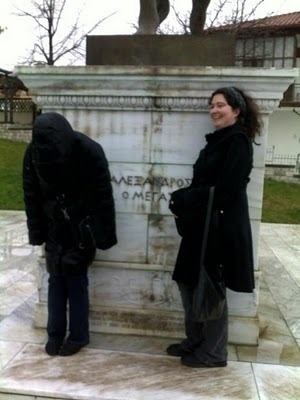
At last, we discovered the new Archaeological Museums of Pella on the outskirts. A large sign outside explained the vast sum spent by the EU on the impressive new building - so new its website is still under construction, though the place has been open since 2009. It seemed a lot of money for a place that had made it so hard to get to, and the small, narrow car park didn't exactly suggest it sees much traffic from cars and coaches. There were more staff than visitors, who followed us round like wardens, telling us we were allowed to take photos without a flash, and then telling us off if we did so.
Again, the actual artefacts were very impressive - some huge and well-preserved mosaics with lots of willy on show, all sorts of domestic and funerary bits and pieces that gave a glimpse of real people's lives. Photographs showed us just how far the archaeological site extended - the outline of a vast city still there because, after it was destroyed in an earthquake, the locals rebuilt their town further along the hill.
Again, the labels insisted that the dialects in the writing and the artistic styles linked these objects entirely and unquestionably to hellenic traditions, so that (the implication was ladled on) 2,500 years later Macedonia can't be anything other than Greek. I think you could probably make the same case for anywhere else Alexander conquered - Egypt, Iran or India.
There was no shop to buy books or postcards, and we could not visit any part of the huge archaeological site - which the old museum had been right in the heart of. It all felt a bit cold and unwelcoming for such a new and expensive place. We tramped back to the bus stop and sulked until a bus came.
Though it sometimes lacked in presentation, don't get me wrong: the sites and artefacts are amazing and it was mostly a great joy to plod about looking at stuff. The churches were all very welcoming, and often contained beautiful frescos. I felt a bit awkward being welcomed inside to look round during the middle of a service. Even when things were quiet, you feel a bit intrusive stood there gawping while devout local people slink to kiss the icons.
There were fun bits of Mediterranea, too, the little differences that remind you you're abroad. D gleefully ignored the no smoking signs in restaurants (one old chap in one restuarant at least made an effort to hide his fag below the edge of the table). The crossword and puzzle books on sale at all the kiosks had bikinied lovelies on their covers - what with that correlation between glamour* and wordsearches.
(* - that is, soft porn but with clothes on.)
The Greek alphabet also kept me childishly amused:

& Toot! - and with a cone of meat. And this logo for telecommunications was everywhere:

But the chief highlight was seeing the Dr relax, grinning round the museums and churches, not thinking about all the stressy house-buying stuff and, er, throwing herself into some shameless cat-adultery...
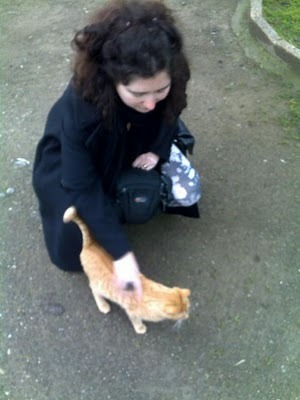
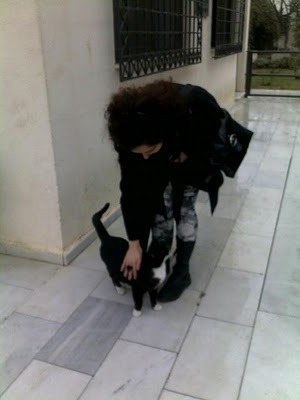
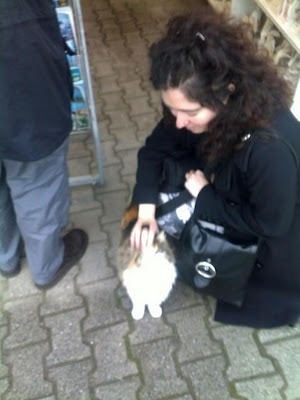
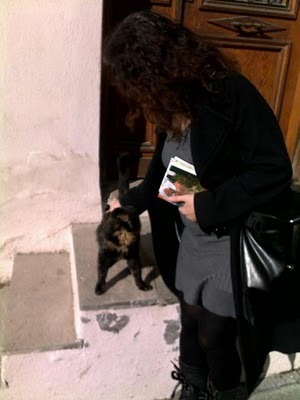

I managed the first 200 pages of Mark Mazower's Salonica, which is brilliantly rich and well researched but a bit heavy for holiday reading. He charts the complex, multi-ethnic history of the city under Ottoman rule, comparing the different customs, manners and superstitions:
"Holy water helped Christians, Bulgarians were fond of salt; others used the heads of small, salted fish mixed in water, while everyone believed in the power of spitting in the face of a pretty child."He also speaks of the power of pentagrams to Muslims, "for keeping babies in good health", and on the next page,
Mark Mazower, Salonica - City of Ghosts, p. 85.
"Against the fear of infertility, ill health, envy or bad luck, the barriers between faiths quickly crumbled."The Dr's chief interest was the classical history. The Archaeological Museum has a new digitisation project, Macedonia: From Fragment to Pixels, and we had fun spotting Gods in an interactive wordsearch and making information pop up on maps. We were also wowed by the Myrtis exhibition, where different scientific methods help bring back to life a small girl who died in the 5th century BC.
Ibid., p. 86.
Sadly, a lot of the main museum was closed while we were there, but what we did mooch round was beautifully displayed and interpreted. The Dr especially liked seeing a Roman-period dining table recreated 'live' from a contemporary illustration and using real artefacts.
The Museum of Byzantine Culture was free and quick to look round, with some nicely displayed bits of fresco. We tried several attempts to get into the open-air Roman forum, but always managed to find it closed so took pictures from the edges.

On our second full day, the Dr expertly guided us out by bus to the bus station (always well out of town in Greek cities), and thence onto a bus to Vergina and the tumulus tomb where Alexander the Great buried his dad, Phillip II. It took a bit of wandering through the drizzle to find, and then it didn't look much - a bit of grassy hillock.


But inside was something else entirely: the most amazing museum of all the spectacular riches discovered in the tombs, right next to the tomb doorways in situ. The low-light only enhanced the splendor of the gold, but it was the simple, practical and perfectly preserved cups and pots that impressed - it was hard to believe they were 250 let alone 2,500 years old.
The haul included organic relics - so rare in archaeology of this age. There was a purple cloth with gold thread design, carvings in wood and ivory.
The tomb doorway showed a rare example of ancient Greek fresco painting, showing a hunting scene. On the tops of the doors were still vivid, bright highlights of orange and blue - again, a small detail that makes this ancient, strange civilisation so tangible.
If there was one slight off note, it was the insistence of some of the labels to explain that the finds showed that this ancient civilisation was characteristially Greek - a political claim as much to do with Macedonia's recent history as the past. The god-king buried here in such finery would have sat uncomfortably with the hellenic Spartans and Athenians - who so famously managed without monarchy. It was telling, not showing, forcing an opinion rather than letting us interpret the facts.
But otherwise, it was an extraordinary place and we dawdled round at the end, not really wanting to leave. (It was also all a bit The Daemons - an iconic image of Alexander even showed him with horns.)
The next day we tried Pella, Phillip's capital city and the birthplace of Alexander. This time, our bus efforts were less successful. First we ended up in Giannitsa because our bus driver forgot to drop us off in the right place, despite the Dr asking him specifically beforehand and his nodding as she pointed at the word 'Pella' on our ticket. In Giannitsa he only shook his head - we should have called out to stop the bus when we wanted to get off, what with our psychic knowledge of Macedonia having not visited before, and ignoring the fact that (as we discovered on the bus back again) that he'd not taken the Pella road in the first place.
And we'd been watching very carefully, too - because all along the route there were impressive tumulus tombs in the otherwise flat plains of farmland, all of them cool and alluring, and none of them labelled in big letters so you could identify them from the road.
The bus back deposited us in the pouring rain at a lowly bus stop with a big sign declaring 'Pella' and a map of where things might be.
 This solitary map was some way out of town, so we schlepped up through the lashing rain away from it and wandered round and round the town, stopping to take photos of our sodden holiday at the ankles of a big statue of Alexander.
This solitary map was some way out of town, so we schlepped up through the lashing rain away from it and wandered round and round the town, stopping to take photos of our sodden holiday at the ankles of a big statue of Alexander.
At last, we discovered the new Archaeological Museums of Pella on the outskirts. A large sign outside explained the vast sum spent by the EU on the impressive new building - so new its website is still under construction, though the place has been open since 2009. It seemed a lot of money for a place that had made it so hard to get to, and the small, narrow car park didn't exactly suggest it sees much traffic from cars and coaches. There were more staff than visitors, who followed us round like wardens, telling us we were allowed to take photos without a flash, and then telling us off if we did so.
Again, the actual artefacts were very impressive - some huge and well-preserved mosaics with lots of willy on show, all sorts of domestic and funerary bits and pieces that gave a glimpse of real people's lives. Photographs showed us just how far the archaeological site extended - the outline of a vast city still there because, after it was destroyed in an earthquake, the locals rebuilt their town further along the hill.
Again, the labels insisted that the dialects in the writing and the artistic styles linked these objects entirely and unquestionably to hellenic traditions, so that (the implication was ladled on) 2,500 years later Macedonia can't be anything other than Greek. I think you could probably make the same case for anywhere else Alexander conquered - Egypt, Iran or India.
There was no shop to buy books or postcards, and we could not visit any part of the huge archaeological site - which the old museum had been right in the heart of. It all felt a bit cold and unwelcoming for such a new and expensive place. We tramped back to the bus stop and sulked until a bus came.
Though it sometimes lacked in presentation, don't get me wrong: the sites and artefacts are amazing and it was mostly a great joy to plod about looking at stuff. The churches were all very welcoming, and often contained beautiful frescos. I felt a bit awkward being welcomed inside to look round during the middle of a service. Even when things were quiet, you feel a bit intrusive stood there gawping while devout local people slink to kiss the icons.
There were fun bits of Mediterranea, too, the little differences that remind you you're abroad. D gleefully ignored the no smoking signs in restaurants (one old chap in one restuarant at least made an effort to hide his fag below the edge of the table). The crossword and puzzle books on sale at all the kiosks had bikinied lovelies on their covers - what with that correlation between glamour* and wordsearches.
(* - that is, soft porn but with clothes on.)
The Greek alphabet also kept me childishly amused:

& Toot! - and with a cone of meat. And this logo for telecommunications was everywhere:

But the chief highlight was seeing the Dr relax, grinning round the museums and churches, not thinking about all the stressy house-buying stuff and, er, throwing herself into some shameless cat-adultery...




Published on January 26, 2011 18:25
January 9, 2011
Units of licenced merchandise
Those fine fellows at BBC Worldwide / 2|entertain have put a whole load of Doctor Who clips up on YouTube, including a snippet of a documentary what me and the brother done made.
Meglos is out on DVD this month with this documentary and another one by us on it. And we've got stuff on The Mutants and The Ark, too, which are released in coming weeks.
Also, Big Finish now have a cover and trailer up for The Perpetual Bond,out next month - a new adventure for the First Doctor and starring Peter Purves and Tom Allen. I've also got a short story on the second volume of Short Trips: 'Letting Go' features the Eighth Doctor and is read by India Fisher.
My Primeval book is now out in paperback, too.
Meglos is out on DVD this month with this documentary and another one by us on it. And we've got stuff on The Mutants and The Ark, too, which are released in coming weeks.
Also, Big Finish now have a cover and trailer up for The Perpetual Bond,out next month - a new adventure for the First Doctor and starring Peter Purves and Tom Allen. I've also got a short story on the second volume of Short Trips: 'Letting Go' features the Eighth Doctor and is read by India Fisher.
My Primeval book is now out in paperback, too.
Published on January 09, 2011 10:49
January 6, 2011
Books finished, December 2010
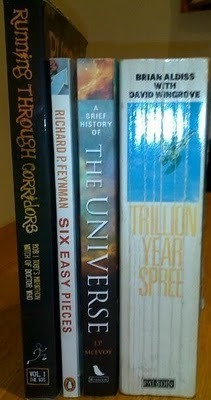 I enthused about volume one of Running Through Corridors by my chums Robert Shearman and Toby Hadoke the other day.
I enthused about volume one of Running Through Corridors by my chums Robert Shearman and Toby Hadoke the other day.One thing I didn't mention is that, like a lot of small-press publications it's got a fair few typos. That's less a criticism as an acknowledgment that my own work has been blessed with some extremely accomplished editors. Developments in publishing in recent decades mean that books are produced by an every smaller team of people. That has a whole load of benefits to the industry, but it also means they are checked by ever fewer eyes. Good subs are therefore worth more than ever.
Good sub questions like 'Who is this aimed at?' kept bothering me as I read through my next two books. Richard P Feynman's Six Easy Pieces is not quite what it says on the cover. The word "easy" suggests it might be entry-level stuff, physics for the plebs. But even with all my recent reading and study, a lot of it went over my head. It's certainly not as layman-friendly as Feynman's Fun to Imagine series at the BBC Archive, which was what prompted me to pick up the book.
It's taken from a longer collection of lectures on physics, which Feynman delivered back in the early 1960s. And the thing that sticks in my mind is that these lectures weren't exactly a roaring success:
"Through the distant veil of memory, many students and faculty attending the lectures have said that having two years of physics with Feynman was the experience of a lifetime. But that's not how it seemed at the time. Many of the students dreaded the class, and as the course wore on, attendance by the registered students started dropping alarmingly. But at the same time, more and more faculty and graduate students started attending. The room stayed full, and Feynman may never have known he was losing some of his intended audience. But even in Feynman's view his pedagogical endeavor did not succeed. He wrote in the 1963 preface to the Lectures: 'I don't think I did very well by the students' ... Even when he thought he was explaining things lucidly to freshman or sophomores, it was not really they who were able to benefit most from what he was doing. It was his peers - scientists, physicists, and professors - who would be the main beneficiaries..."Despite failing his intended audience, Goodstein and Neugauer speak of Feynman's "magnificent achievement" and continue in the very next sentence that,
David L Goodstein and Gerry Neugbauer, 'Special Preface (from Lectures on Physics) in Richard P Feynman, Six Easy Pieces, pp. xx-xxi.
"Feynman was more than a great teacher..."He might have been all very clever, but this jobbing freelancer muttered at that last statement.
Ibid.
JP McEvoy's A Brief History of the Universe (in the same series as Jonathan Clement's book on the Vikings) is a more pleb-friendly volume, taking us through the discoveries and developments in science since ancient times.
The history of discovery is a good way for explaining science to lay people as it makes it about people and drama. Bronowski's The Ascent of Man does the same thing very effectively.
And yet McEvoy's book is very oddly ordered. He'll use technical terms such as the ecliptic several times before explaining what they mean, and discusses both Kepler and Newton's three laws in some depth before listing what they are. A good few times, a late explanation had me flipping back a few pages to read a whole section again.
At first I thought this was down to the author not knowing quite what level of knowledge to assume from the reader. But there's also a lot of odd repetition through the book. On page 228, McEvoy tells us that,
"Hubble changed our view of the universe more than any astronomer since Galileo",and a page later makes the same point:
"[Hubble] changed man's view of the universe as much as Copernicus and Galileo".The Whirlpool Galaxy is another example: it's first mentioned on page 150:
"Rosse was the first to see the spiral structure of what was later known as the Whirlpool Galaxy."A paragraph later:
"[Messier's Catalogue of Nubulae and Star Clusters] was useful to Rosse who listed several of the nebulae on Messier's list, including M51, also known as the Whirlpool Galaxy."Two pages later, there's a mention of the,
"famous Whirlpool Galaxy (classified by Messier as M51), one of the most conspicuous, and best known spiral galaxies in the sky. M51 was of one Charles Messier's original discoveries in 1773 and was sketched by Lord Rosse in 1845."It's not merely the three mentions in as many pages that's so clumsy, but that the detail is in the last one: we could have just had that to begin with. (A later reference on page 237 wisely reminds us of Messier and his classification system when referring to the M51.)
This sort of thing shouldn't matter but it's distracting. It's also indicative of a tendency to jump back and forth through the subject which can make it difficult to follow. That's a shame because the subject is thrilling and McEvoy's prose style usually simple and vivid.
And then on to made-up science. Brian W Aldiss and David Wingrove's Trillion Year Spree, is a comprehensive history of science fiction published in the mid 1980s (and a follow-up to an earlier volume). The authors argue that sf is a sub-genre of the gothic and began with Mary Shelley's Frankenstein. They trace the highs and lows of the form through the next nearly two centuries, mostly focusing on US and UK work.
As a leading figure in sf himself, Aldiss is able to provide plenty of insights and gossip. Opinions of authors are often as much about what they were like in person as analyses of their work. There are a few fun jokes and bits of wordplay – one author is described as "more syndicated than sinning" – and quite a lot of bad ones.
There's an odd habit of paragraphs that only last one sentence.
But there's not a great deal of depth, I felt. Rather the authors provide an annotated reading list of the "good stuff". It's telling, then, that Doctor Who gets one mention in passing while Star Trek's television series gets 6 entries and its four movies separately. A modern history of sf – especially one with such a British focus – wouldn't do that now. And last year, Aldiss made his Doctor Who writing debut with a short story for the Brilliant Book. There's a small schoolboy part of me that still can't quite believe how much things have transformed.
There are other signs of the period in which this was written – such as that Iain Banks will be writing an explicitly sf novel next – but my main impression on reading titbits of the many authors' lives is how little had changed. As Aldiss and Wingrove say themselves,
"It's evident, then as now, that the authors most eager to write for the quick buck are the ones most easily exploited by publishers."And, so perfectly put, the "rules of labour" in writing splendid hokum remain entirely unchanged:
Brian W Aldiss and David Wingrove, Trillion Year Spree, p. 168.
"Write fast, do the unexpected, deliver on time, collect the cheque."For the record, that's 48 books finished in 12 months, which is not too shabby (December - 4; November - 4; October - 4; September - 7; August - 0; July - 4; June - 4; May - 5; April - 4; March - 5; February - 3; January - 4). Not going to do these monthly things any more - they're too much of a bother. But have some more blogging 'bout books to come. Oh, aren't you fortunate?
Ibid., p. 468.
Published on January 06, 2011 19:00
January 2, 2011
Books finished, November 2010
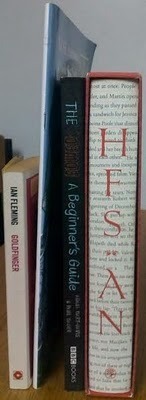 Catching up on the books of 2010. Goldfinger deserves a post of it's own sometime - and I certainly made loads of notes. But blimey, it's an odd book, with a interminably dull golf match that stretches over chapters being followed by an equally dull drive to Switzerland. So many of the iconic moments from the film - such as the girl killed by being painted gold - are reported rather than seen, and even for a Bond book there's a lot of casual racism.
Catching up on the books of 2010. Goldfinger deserves a post of it's own sometime - and I certainly made loads of notes. But blimey, it's an odd book, with a interminably dull golf match that stretches over chapters being followed by an equally dull drive to Switzerland. So many of the iconic moments from the film - such as the girl killed by being painted gold - are reported rather than seen, and even for a Bond book there's a lot of casual racism.Some of that is the time in which it was written - Fleming also need to explain to the reader what karate is, and the term "'hit' - mobese for murder" (p. 186). But that will only go so far. Bond's thoughts on a girl who's not interested in him, and on where gayness might come from, are quite a surprise:
"Bond came to the conclusion that Tilly Masterson was one of those girls whose hormones had got mixed up. He knew the type well and thought they and their male counterparts were a direct consequence of giving votes to women and 'sex equality'. As a direct result of fifty years of emancipation, feminine qualities were dying out or being transferred to the males. Pansies of both sexes were everywhere, not yet completely homosexual, but confused, not knowing what they were. The result was a herd of unhappy sexual misfits - barren and full of frustrations, the women wanting to dominate and the men to be nannied. He was sorry for them, but he had no time for them."Of course, later Bond will convert the lesbian Pussy Galore so that she throws off a life of crime and ladies to help Bond stop the villains and get into his bed. We learn that Pussy is only a lesbian because she was abused by her uncle, and that all this time she's been waiting for a real man.Ian Fleming, Goldfinger, p. 189.
That this man turns out to be Bond is not merely reactionary fantasy but also a massive cheat in the plot. Pussy has only met Bond once - and briefly - before she switches sides. That's during a meeting between Goldfinger and America's fiercest hoodlums, where Bond is being Goldfinger's secretary. He doesn't say anything, let alone do anything to attract her attention. The 'real man' she falls for is the quiet one doing shorthand in a room full of toughs. Really not good enough, 007.
GCSE Astronomy - A Guide for Pupils and Teachers (1999) relates to an older version of the syllabus than the one I'm doing, but outlines the main topics and homework projects which is all very useful.
The Cosmos - A Beginnner's Guide is also me swotting up for class. Accompanying the TV series, it's an enthusiastic trawl through some of the big ideas and newer theories, with a particular pleasure in big machinery and diagrams.
Her Fearful Symmetry is sort of The Graveyard Book as told by Richard Curtis. The male hero is an embarrassed, slightly rubbish Hugh Grant type who falls under the spell of an American girl. He lives alone in a large flat in an expensive part of London without having to work, and is doing a PhD without apparently having to see a supervisor or, you know, actually do a lot of work or anything.
In fact, most of the characters idle along, going to museums and strange bits of London not in their lunch hours and stolen moments of the day but because they're filling time. There's none of the urgency, the effort, to earn enough for the costly capital city, and little of the noise and richness and mixture.
Highgate is just a stone's throw from Archway but is apparently an oasis of old-skool Englishness where no one is Black or gay. Everyone speaks English apart from two eccentric linguists - we get some wry stuff about the differences between American English and the local vernacular, but that's about it.
The volunteers running the cemetery are all sweet and understanding old dears - there's none of the petty jealousies, intrigues and empire-building that bother any place of work, especially one run by enthusiasts. As a result, it's an idyll of London which never quite rings true.
At one point, the book seems to notice this:
"Julia began to play a game that entailed travelling on the tube and randomly popping out at stations with interesting names: Tooting Broadway, Ruislip Gardens, Pudding Mill Lane. Usually the above-ground reality disappointed her. The names on the tube map evoked a Mother Goose cityscape, cosy and diminutive. The actual places tended to be grim: takeaway chicken shops, off-licences and Ladbrokes crowded out whimsy."But this may all be intentional, as the veil of unreality about the world matches the strange and sad and beautiful ghost story. It reminded me chiefly of the death of Simon Callow's character in Four Weddings - with the same awkwardness of feelings amongst a group of decent but unfulfilled people, the same peculiar peccadilloes and the knowledge that there can't be a happy ending, only one that's bittersweet.Audrey Niffenegger, Her Fearful Symmetry, p. 255.
It's an odd book, and haunting, but not quite as brilliant as The Time Traveller's Wife.
Published on January 02, 2011 17:22
December 31, 2010
Catching up
Blimey. 2010 has been a bit of an old sod, all told. Having had next to no work for most of the summer, things suddenly got a bit manic in the last few months. Hence the lack of blogging. What follows is a splurge of me trying to catch up, more for my own future interest than yours.
My day job since September has been at Doctor Who Adventures, which has been a joy. It's quite a trek into the office and back - especially when there's any hint of weather - but that's given me lots of time for reading, which I'll try to blog about in the next few days.
At the end of November, the Dr and I jetted off to the States so I could spend the weekend showing off at Chicago TARDIS. Had a brilliant time - and the Dr made her debut on a convention panel, too. As always, there was too little time to natter with some very good friends and it was all over too quickly. But Graceless - which me, Ciara Janson and Laura Doddington were there to flog - seemed to go down well.
I also got a copy of Running Through Corridors by my chums Rob Shearman and Toby Hadoke, in which they watch all of black-and-white Doctor Who, two episodes per night. It's a pleasure to be in their company anyway, and the book is full of smart insights and jokes. It helps that Rob's a professional writer (he wrote for Doctor Who on TV himself) and Toby a jobbing actor - that experience gives them more of an 'in' to the mechanics of the programme than many other guides.
My favourite bits were when the two authors disagree over something and where real life crops up as part of the diaries - when their (non-fan) spouses chip in thoughts, or where the authors tell us about personal links to the stories. It's also fun just seeing how they juggle the watch round conventions and train journeys and things: the everyday minutiae of being a fan, fitting the programme around real life. Can't wait for the next volume.
After the convention, the Dr and I bussed up to Madison, Wisconsin to stay with some friends. We poddled round Madison and ate huge burritos, but mostly we spent the week loafing about. That was, sadly, quite a highlight of my year. I wrote two chapters of the Novel, read a fair bit and also did some thinking, which is a crucial part of being a freelancer and not something I've had much time for recently.
We returned to Chicago for one last night, and went out for a splendid dinner with T. All the time we were away we'd heard horror stories of the snow in London and how civilisation had collapsed. But on our last day the snow came down in Chicago - and it made not a jot of difference. We wrapped up warm and ventured out into the street, where the cars and buses and trains were all running just fine.
We caught the train down to the Museum of Science and Industry, where we had time to look round the U505 German submarine before going into Jim Henson's Fantastic World (runs until 23 January 2011).
Cor, that was fun. It's a comprehensive history of Henson's work, with many original sketches and puppets amid film clips and live performances. I'd seen a lot of the sketches before (in Jim Henson's Designs and Doodles - a Muppet Sketchbook), but its a very different thing then seeing clips of the realised creatures, shambling about.
I loved seeing Henson's non-Muppets work - his adverts, his documentaries, his experimental films. The producers of Sesame Street apparently brought him on board because they'd noticed that children were hooked on the speed and brightness of adverts. The Dr was much taken with the exhibition and is going to use it as the basis of some report thing she has to do at work.
As always, the museum shop was full of things we didn't want and had little that we did. So we made our way to the airport. Blimey, O'Hare Airport is a dreary place to sit for hours. There's little in the way of shops or distractions - you have to go back out of Passport Control for most things, and the one bar was the only place to ID me the whole time we were away.
But the plane home was pretty much on time and unencumbered by the snow. I watched Inception and Salt, neither of which really did anything for me. (On the way out, I watched Agora - featuring Rachel Weisz, and her nekkid bum in one bit - and Toy Story 3. The Dr cried at the sacking of the Library of Alexandria, I did not so much as sniffle at the toys. Honestly.)
Got home to find a crazy world of emails hollering for work. Since getting back I've written one play and pitched for four more - just as well I had that thinking time! The brother/boss also needed a final, final rewrite on our short film, having fixed the location.
Oh yes: we've made a film. Cleaning Up stars Mark Gatiss, Louise Jameson and lots of brilliant people, and was shot the weekend after I got back. I'd been working on the script since 2008 - and intensively over the last year, since Joseph Lidster signed up as script editor - but suddenly it was real, with a whole massive film crew. Mad and exciting, and I'm really rather proud of the brother/boss. He, producer Ben Greenacre and everyone else just worked wonders. I sort of stood in a corner and tried not to get in the way. There'll be plenty more about the film in the new year, sorry.
I also got to see Gatiss in Seasons Greetings - which is magnificently funny and runs til 13 March. And I've seen Harry Potter 7.1 twice. While I appreciate all Jonny's shrewd remarks, I still pretty much loved every second.
And then it's been working and working. The day job, some interviews, a comic strip or three, a magazine feature, a play and a world of pitches... It's feast or famine in this job, but all told, I'm knackered. Whited out on Christmas Day and went to bed with a migraine for most of the afternoon, then spent the next day carefully not doing anything. I start a part-time job in a couple of weeks that I'm hoping will make life slightly less fraught and more orderly.
Meanwhile, the Dr has been slaving away at the paperwork so that we can move house. And once that's done she can have a second cat - one she's already selected. Lots of changes in the air, and lots we have to do, but things are on the up... It's been a hell of a year, and I'm quite glad to see the back of 2010. But 2011 is already looking exciting. Let's see what can go wrong...
My day job since September has been at Doctor Who Adventures, which has been a joy. It's quite a trek into the office and back - especially when there's any hint of weather - but that's given me lots of time for reading, which I'll try to blog about in the next few days.
At the end of November, the Dr and I jetted off to the States so I could spend the weekend showing off at Chicago TARDIS. Had a brilliant time - and the Dr made her debut on a convention panel, too. As always, there was too little time to natter with some very good friends and it was all over too quickly. But Graceless - which me, Ciara Janson and Laura Doddington were there to flog - seemed to go down well.
I also got a copy of Running Through Corridors by my chums Rob Shearman and Toby Hadoke, in which they watch all of black-and-white Doctor Who, two episodes per night. It's a pleasure to be in their company anyway, and the book is full of smart insights and jokes. It helps that Rob's a professional writer (he wrote for Doctor Who on TV himself) and Toby a jobbing actor - that experience gives them more of an 'in' to the mechanics of the programme than many other guides.
My favourite bits were when the two authors disagree over something and where real life crops up as part of the diaries - when their (non-fan) spouses chip in thoughts, or where the authors tell us about personal links to the stories. It's also fun just seeing how they juggle the watch round conventions and train journeys and things: the everyday minutiae of being a fan, fitting the programme around real life. Can't wait for the next volume.
After the convention, the Dr and I bussed up to Madison, Wisconsin to stay with some friends. We poddled round Madison and ate huge burritos, but mostly we spent the week loafing about. That was, sadly, quite a highlight of my year. I wrote two chapters of the Novel, read a fair bit and also did some thinking, which is a crucial part of being a freelancer and not something I've had much time for recently.
We returned to Chicago for one last night, and went out for a splendid dinner with T. All the time we were away we'd heard horror stories of the snow in London and how civilisation had collapsed. But on our last day the snow came down in Chicago - and it made not a jot of difference. We wrapped up warm and ventured out into the street, where the cars and buses and trains were all running just fine.
We caught the train down to the Museum of Science and Industry, where we had time to look round the U505 German submarine before going into Jim Henson's Fantastic World (runs until 23 January 2011).
Cor, that was fun. It's a comprehensive history of Henson's work, with many original sketches and puppets amid film clips and live performances. I'd seen a lot of the sketches before (in Jim Henson's Designs and Doodles - a Muppet Sketchbook), but its a very different thing then seeing clips of the realised creatures, shambling about.
I loved seeing Henson's non-Muppets work - his adverts, his documentaries, his experimental films. The producers of Sesame Street apparently brought him on board because they'd noticed that children were hooked on the speed and brightness of adverts. The Dr was much taken with the exhibition and is going to use it as the basis of some report thing she has to do at work.
As always, the museum shop was full of things we didn't want and had little that we did. So we made our way to the airport. Blimey, O'Hare Airport is a dreary place to sit for hours. There's little in the way of shops or distractions - you have to go back out of Passport Control for most things, and the one bar was the only place to ID me the whole time we were away.
But the plane home was pretty much on time and unencumbered by the snow. I watched Inception and Salt, neither of which really did anything for me. (On the way out, I watched Agora - featuring Rachel Weisz, and her nekkid bum in one bit - and Toy Story 3. The Dr cried at the sacking of the Library of Alexandria, I did not so much as sniffle at the toys. Honestly.)
Got home to find a crazy world of emails hollering for work. Since getting back I've written one play and pitched for four more - just as well I had that thinking time! The brother/boss also needed a final, final rewrite on our short film, having fixed the location.
Oh yes: we've made a film. Cleaning Up stars Mark Gatiss, Louise Jameson and lots of brilliant people, and was shot the weekend after I got back. I'd been working on the script since 2008 - and intensively over the last year, since Joseph Lidster signed up as script editor - but suddenly it was real, with a whole massive film crew. Mad and exciting, and I'm really rather proud of the brother/boss. He, producer Ben Greenacre and everyone else just worked wonders. I sort of stood in a corner and tried not to get in the way. There'll be plenty more about the film in the new year, sorry.
I also got to see Gatiss in Seasons Greetings - which is magnificently funny and runs til 13 March. And I've seen Harry Potter 7.1 twice. While I appreciate all Jonny's shrewd remarks, I still pretty much loved every second.
And then it's been working and working. The day job, some interviews, a comic strip or three, a magazine feature, a play and a world of pitches... It's feast or famine in this job, but all told, I'm knackered. Whited out on Christmas Day and went to bed with a migraine for most of the afternoon, then spent the next day carefully not doing anything. I start a part-time job in a couple of weeks that I'm hoping will make life slightly less fraught and more orderly.
Meanwhile, the Dr has been slaving away at the paperwork so that we can move house. And once that's done she can have a second cat - one she's already selected. Lots of changes in the air, and lots we have to do, but things are on the up... It's been a hell of a year, and I'm quite glad to see the back of 2010. But 2011 is already looking exciting. Let's see what can go wrong...
Published on December 31, 2010 12:54
December 23, 2010
Validation
Published on December 23, 2010 16:18
November 17, 2010
Telescope cherry
Of no interest to anyone else I am sure, but yesterday I looked up at space through a telescope for the first time.
My astronomy GCSE course has attempted this before, and again last night we trooped up to the famous 28" inch refracting telescope (the one used by Karen Gillan in Doctor Who Confidential earlier this year) only to find the view again obscured by clouds. The proper astronomer and our teacher filled time, explaining the history and mechanisms and testing our new-learnt knowledge. We waited and waited, and used a clever gadget called a 'window' to check if the sky might be clearing, but eventually decided to troop back into the warm.
Once we'd watched the telescope get put to bed and trooped down the steps and outside the Moon couldn't have been clearer - the tease. So the intrepid Nick who organises our group quickly found us an 8" inch reflector built by Meade: a bucket-shaped thing about the length of my forearm.
As the experts put this contraption together, Nimbos and grabbed a cup of tea and were then out in the cold again to queue up for a look.
The waxing gibbous moon looked shiny bright to the naked eye and, as thin cloud occasionally brushed over it, produced a glowing halo. This is due to icy crystals in the wintry cold atmosphere, which refract moonlight. The centre of the halo is bluish, the edge of it red - for the same reason as the different colours of the rainbow.
Looking through the telescope was something else entirely. At first I could see nothing but a white blur - as we'd been queuing the Earth's rotation had moved the telescope a bit. The helpful astronomer adjusted the setting and then - oh blimey - I saw.
A curved, gleaming surface of white, splotched with little craters, so bright it looked like plaster of Paris that had not quite set, the splotches made just a moment before I looked. The edges of these feature cast long, distinct shadows, picking out the details. The surface rippled slightly, as if I was looking through clear water - an effect of Earth's atmosphere refracting the light, something astronomers call 'seeing'. But another world, and in plain sight, tantalising, just out of reach.
Once we'd all wowed at this incredible view, the astronomers moved the telescope and trained it on Jupiter. With the naked eye, the huge planet looked like a bright star, hanging at about five o'clock below the Moon. Before we'd ventured out into the cold, we'd look at it using the free - and cool - Stellarium software which gave us an idea of what to expect: Jupiter in a line with its four largest moons.
But to actually see it! I took a moment to realise what I was looking at - the telescope flipping the image upside down, a reflection of the Stellarium cheat. A murky, stripey ball hanging in the darkness at the centre of the eyepiece. To the left (in reality, to the right) three bright stars - just the same size as Jupiter appeared to the naked eye. On the right, another star.
These moons, first seen by Galileo 400 years ago, transformed our understanding of our place in the universe. For more than 2,000 years the assumption had been that the Earth was at the centre of everything, that the celestial bodies looped slowly around us. Galileo tracked the positions of his four Galilean moons and showed why they moved and sometimes vanished. Now here was evidence of Moons circling something else: proof that we're not at the centre of things, the first sign that we live and toil on an insignificant sticky rock circling an insignificant star.
That is, except for something that's not insignificant: we look up.
My astronomy GCSE course has attempted this before, and again last night we trooped up to the famous 28" inch refracting telescope (the one used by Karen Gillan in Doctor Who Confidential earlier this year) only to find the view again obscured by clouds. The proper astronomer and our teacher filled time, explaining the history and mechanisms and testing our new-learnt knowledge. We waited and waited, and used a clever gadget called a 'window' to check if the sky might be clearing, but eventually decided to troop back into the warm.
Once we'd watched the telescope get put to bed and trooped down the steps and outside the Moon couldn't have been clearer - the tease. So the intrepid Nick who organises our group quickly found us an 8" inch reflector built by Meade: a bucket-shaped thing about the length of my forearm.
As the experts put this contraption together, Nimbos and grabbed a cup of tea and were then out in the cold again to queue up for a look.
The waxing gibbous moon looked shiny bright to the naked eye and, as thin cloud occasionally brushed over it, produced a glowing halo. This is due to icy crystals in the wintry cold atmosphere, which refract moonlight. The centre of the halo is bluish, the edge of it red - for the same reason as the different colours of the rainbow.
Looking through the telescope was something else entirely. At first I could see nothing but a white blur - as we'd been queuing the Earth's rotation had moved the telescope a bit. The helpful astronomer adjusted the setting and then - oh blimey - I saw.
A curved, gleaming surface of white, splotched with little craters, so bright it looked like plaster of Paris that had not quite set, the splotches made just a moment before I looked. The edges of these feature cast long, distinct shadows, picking out the details. The surface rippled slightly, as if I was looking through clear water - an effect of Earth's atmosphere refracting the light, something astronomers call 'seeing'. But another world, and in plain sight, tantalising, just out of reach.
Once we'd all wowed at this incredible view, the astronomers moved the telescope and trained it on Jupiter. With the naked eye, the huge planet looked like a bright star, hanging at about five o'clock below the Moon. Before we'd ventured out into the cold, we'd look at it using the free - and cool - Stellarium software which gave us an idea of what to expect: Jupiter in a line with its four largest moons.
But to actually see it! I took a moment to realise what I was looking at - the telescope flipping the image upside down, a reflection of the Stellarium cheat. A murky, stripey ball hanging in the darkness at the centre of the eyepiece. To the left (in reality, to the right) three bright stars - just the same size as Jupiter appeared to the naked eye. On the right, another star.
These moons, first seen by Galileo 400 years ago, transformed our understanding of our place in the universe. For more than 2,000 years the assumption had been that the Earth was at the centre of everything, that the celestial bodies looped slowly around us. Galileo tracked the positions of his four Galilean moons and showed why they moved and sometimes vanished. Now here was evidence of Moons circling something else: proof that we're not at the centre of things, the first sign that we live and toil on an insignificant sticky rock circling an insignificant star.
That is, except for something that's not insignificant: we look up.
Published on November 17, 2010 14:09
November 11, 2010
Meat feast
Had lunch at the Westfield Byron Burger today with m'learned colleagues and chose the double Byron because I is a pig. Finished before anyone else too. Oink oink.



Published on November 11, 2010 20:37
November 5, 2010
Where's Simon?
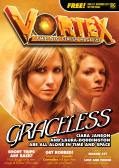 Graceless, the three CD sci-fi mini-series what I wrote, is out this month. The Big Finish website boasts full details and a trailer, and the new issue of free online Vortex magazine interviews stars Ciara Janson and Laura Doddington.
Graceless, the three CD sci-fi mini-series what I wrote, is out this month. The Big Finish website boasts full details and a trailer, and the new issue of free online Vortex magazine interviews stars Ciara Janson and Laura Doddington.Ciara will also be at the Dimensions convention next week, along with director Lisa Bowerman and the Big Finish gang. Me, Ciara, Lisa, Laura and a whole cohort of slebs will also be at ChicagoTARDIS at the end of the month. Hooray!
That sadly means I miss Nev Fountain and Nicola Bryant signing copies of the Mervyn Stone Mysteries at Forbidden Planet on 25 November. The books are now out and already garnering nice comments on the internet. I've been helping with the publicity.
Also out now is Cinema Futura, edited by Mark Morris and containing the wise words of many wise people, including my chums Guy Adams, Paul Cornell, Joseph Lidster, James Moran and Rob Shearman. Oh, and there's me going on about the Peter Cushing Doctor Who films.
Plus I've got a story in the new Bernice Summerfield anthology, Present Danger, edited by Eddie Robson. It's the first thing I've written for dear old Benny in three years - back when I was her boss and king.
I'm afraid there's a load more of stuff by me due out over the next few months. Prison in Space, my adaptation of an unmade 1968 Doctor Who story, is out in December (there's a trailer on the site, too). In January, there's The Perpetual Bond starring Peter Purves and Tom Allen, and a whole bunch of Doctor Who DVD documentaries with my name on the credits. Sorry.
I am, meanwhile, manically busy with a whole bunch of stuff. I'm very nearly done on one extremely thrilling project which I've been slaving on for over a year. Announcements and things in due course. Am also having a lovely time at Doctor Who Adventures, am writing comics and short stories for somebody else and am just about keeping up with my space homework. But phew, knackered. Back to work...
Published on November 05, 2010 16:29
Simon Guerrier's Blog
- Simon Guerrier's profile
- 60 followers
Simon Guerrier isn't a Goodreads Author
(yet),
but they
do have a blog,
so here are some recent posts imported from
their feed.


